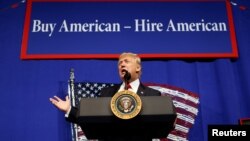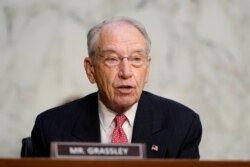The Trump administration's move to curb temporary foreign workers in the United States weeks before the Nov. 3 election shines a spotlight on a much-debated portion of the nation's labor supply that some lawmakers have sought to reform for a decade or more.
At stake are H-1B visas that allow employers to temporarily employ foreign workers in specialty fields. Rules issued earlier this month by the Department of Homeland Security (DHS) restrict H-1B jobs by tightening the definition of “specialty occupation” that qualifies a foreign worker to be hired. Rules issued by the Department of Labor (DOL), meanwhile, boost the minimum wages and salaries U.S. employers must pay foreign workers by 30%.
“Overall, rules are trying to make it difficult for skilled foreign workers to acquire visas and work permits by actually making it more burdensome for the companies sponsoring them,” immigration attorney Rosanna Berardi told VOA.
Boosting the cost of imported labor makes domestic workers more attractive by comparison. Economists say it can also incentivize U.S. firms to move operations overseas rather than bringing increasingly pricey foreign workers to America. The U.S. unemployment rate stood at 7.9% in September, down from nearly 15% in April, but far higher than the 3.5% recorded before the COVID-19 pandemic took hold in America.
Protecting jobs
The Trump administration says its goal is to expand and protect American jobs.
“The U.S. Department of Labor is strengthening wage protections, addressing abuses in these visa programs, and ensuring American workers are not undercut by cheaper foreign labor,” Labor Secretary Eugene Scalia said in a statement.
For its part, DHS said in a press release that data “shows that the more than a half million H-1B nonimmigrants in the United States have been used to displace U.S. workers.”
DHS did not respond to VOA requests for details of the data it referenced.
Immigration advocates contest DHS’s finding. Doug Rand, co-founder of Boundless Immigration, said though there have been cases of employers abusing the H-1B system, multiple studies have found a positive impact of skilled immigration on the wages and employment of both college- and non-college-educated natives.
“Such findings are consistent with the view that skilled immigrants are often complementary to native-born workers, that spillovers of wage-enhancing knowledge and skills occur as a result of interactions among workers, and that skilled immigrants innovate sufficiently to raise overall productivity.” Rand said.
Economists note that the U.S. lags in specialized workers in several critical fields.
“The high-skilled immigrants that we bring in, almost half of them are in STEM [science, technology, engineering and mathematics] fields,” U.S. Federal Reserve Bank of Dallas senior economist Pia Orrenius said. “Whereas, if you look at the college graduates that we produce in the U.S., it’s only about a quarter.”
Capitol Hill
Balancing specialized labor needs with the well-being of American workers has long been sought on Capitol Hill.
Republican Sen. Chuck Grassley of Iowa and Illinois Democratic Sen. Dick Durbin have proposed a series of bipartisan bills on H-1B visas dating back to 2007. Most recently in May, the duo reintroduced legislation covering temporary work visas, as well as L1 visas that allow overseas companies to transfer employees to the United States.
“Congress created these programs to complement America’s high-skilled workforce, not replace it. Unfortunately, some companies are trying to exploit the programs by cutting American workers for cheaper labor,” Grassley said in a statement.
Durbin concurred, saying, “Reforming the H-1B and L-1 visa programs is a critical component of fixing our broken immigration system.”
But Durbin criticized last week’s DHS and DOL rules as a poor substitute for comprehensive legislation, tweeting, “This last-minute step is a ploy to cover up for the President’s broken promise to stop H-1B abuse.”
Bottom lines and profits
Daniel Costa, director of immigration law and policy research at the Washington-based Economic Policy Institute, said America benefits from skilled foreign workers but reforms are needed.
“You can legally bring in a worker for less than what the going rate is for a worker in that area, Costa said. “Companies are going to do what's best for their bottom line and their profits.”
Costa co-authored a recent report showing 60% of H-1B positions certified by DOL are “assigned wage levels well below the local median wage for the occupation,” adding that passing legislation is the “easiest and simplest solution” to reform the temporary foreign workers program.
“But the way this is being done, and at the last minute, just seems like it's politically driven,” Costa said.
Potential legal challenges
Speaking with Bloomberg Law, Cornell University immigration law professor Stephen Yale-Loehr said it remains to be seen “whether the DOL can make such a large change (to the H-1B visa program) through the rule-making process” and whether the rules “pass legal muster.”
“There's going to be lots of lawsuits coming very soon,” Costa said. “Companies that want to hire H-1B's are not going to get the big wage savings that they've gotten before. And then the use of the H-1B program by the outsourcing companies is probably going to be reduced. And this is all assuming the regulations don't get enjoined (halted by a court).”








